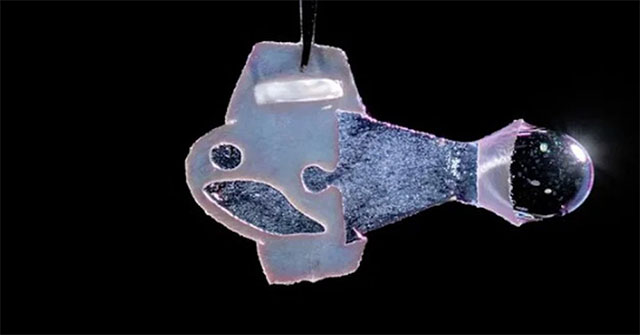Invention of a bio-hybrid fish with human heart cells, wagging its tail to the beat
According to the Daily Beast, although it sounds weird, this invention is intended for research into heart disease.

Kit Parker, a bioengineer at Harvard University and lead researcher on the project, said: "My interest is heart disease in children. I want to develop a heart with modified tissue. repair for children sick with congenital heart defects. But I can't put that heart in a living child without testing it."
Mr. Parker found a way to test the heart. He developed biohybrid fish to see if the modified heart cells could beat and function like a natural heart. Basically, the concept of biohybrid means combining living cells with synthetic materials, which are made from living materials but function more or less as a device or part of a new technology.
Mr. Parker came up with the idea of inventing a bio-hybrid fish once he took his children to the New England Aquarium and saw a jellyfish. "I looked at it and thought it was pumping like a heart pump. I thought I could make that," he said.
Mr. Parker and his team have developed a biohybrid jellyfish that can swim around using mouse heart cells. Next, they invented a biohybrid stingray from mouse heart cells, and "taught" it to contract in response to flashing light.
That work that ultimately helped them invent the biohybrid fish has just been published in a new paper published in the journal Science.
The fish is shaped like a zebrafish (an animal with transparent skin, commonly used in research).
The fish body consists of five different layers: a line of cardiac muscle tissue derived from human stem cells, a layer of rigid paper built using lasers, a layer of gelatin, another layer of paper, and a layer of tissue. last muscle. The caudal fin is where these two layers of muscle cells show their ability. When one side of the cardiac cell of the fin contracts, the other side relaxes and vice versa. This cycle causes the caudal fin to move back and forth and propel the fish forward on its own.

A bio-hybrid fish on a hook. Photo: Daily Beast
Mr. Parker said: "These are principles borrowed from the human heart. The amazing thing is that this activity powered the fish on its own. It swam faster than anything else we've ever built. It lived longer, about 108 days before the team finished the experiment.The biohybrid fish actually learned to swim more efficiently and gradually got a better rhythm.
Another part of the research involved creating an automatic pacemaker (like a pacemaker), which can regulate the frequency and rhythm inside the biohybrid fish.
The study authors hope to apply these inventions to tissue editing, which could one day be used to develop artificial hearts suitable for transplant and save lives, as well as create better pacemakers, which can keep damaged hearts alive longer.
While he won't be able to immediately build an artificial heart next year based on the research, Parker is moving ahead with his plans to build a three-dimensional artificial heart tissue and mimic the chambers that make up a human heart.
- Dogs wagging their tails to express emotions
- The secret of the dog's tail waving direction
- When celebrating the dog wagging its tail to the right
- Successfully developed human heart from stem cells, beating as usual
- Successful rearing of artificial heart muscle tissue is as real, and it is considered an invaluable specimen
- China found a way to cure breakthrough heart failure
- The heart was first cultured from stem cells
- Scientists are creating hybrid animals between humans and monkeys in China
- Successfully implanted artificial hearts for humans
- Creating hybrid virus against antibiotic resistant virus
- Human cells heal heart disease in mice
- Can I create hybrid animals?
 Norway built the world's tallest wooden tower
Norway built the world's tallest wooden tower Kremlin
Kremlin Ashurbanipal: The oldest royal library in the world
Ashurbanipal: The oldest royal library in the world Decoding the thousand-year construction of Qin Shihuang shocked the world
Decoding the thousand-year construction of Qin Shihuang shocked the world Vietnamese doctor creates heart with parameters like human heart
Vietnamese doctor creates heart with parameters like human heart  How does chronic anxiety damage the heart?
How does chronic anxiety damage the heart?  Medical Mystery: Donated Heart Tells New Owner to Find Old Owner's Home, Even Though Identity Is Hidden
Medical Mystery: Donated Heart Tells New Owner to Find Old Owner's Home, Even Though Identity Is Hidden  Space Travel Weakens the Heart: Challenges for Astronauts on Space Exploration Missions!
Space Travel Weakens the Heart: Challenges for Astronauts on Space Exploration Missions!  'Decoding' the heart-shaped symbol
'Decoding' the heart-shaped symbol  Using 'virtual friends' to prevent and treat diseases
Using 'virtual friends' to prevent and treat diseases 